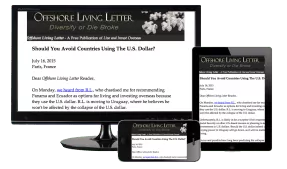
International Investment Through An IRA
IRAs are a great way to grow a portion of your investment assets on a tax-deferred basis. Most Americans have their IRA assets locked up in U.S. stocks, bonds, and mutual funds. The tax code that regulates IRAs and other defined retirement accounts, however, does not place many of the restrictions and limitations on such accounts.
The Wall Street Brokerage Houses that manage them do.
In other words, most Americans’ retirement accounts do not enjoy full access to a world of international investment and true global diversification, simply because it is not expedient or profitable for their brokerage houses to offer such investments.
The following frequently asked questions (FAQs) are designed to educate and inform you about what you really can and can’t do with your hard earned retirement dollars.
1. Is it legal to invest outside the United States with your IRA?
Yes. The tax code does not prohibit individual retirement account funds from investing outside the United States.
2. What can I purchase outside the United States?
Real estate, stocks, bonds, mutual funds…virtually anything you can buy inside the United States.
3. How do I do this practically?
There are several steps:
First, you need to find a U.S. domestic custodian that will allow you to make foreign investments.
Many traditional custodians will not facilitate foreign transactions because that means the money in your account would no longer be trading on their platform.
The custodians that do do this generally advertise that they permit “self-directed” investment. They charge you annual fees based on the custodian and compliance work that they do for you, not based on the transaction revenue.
Next, depending on what you want to purchase, a structure would be created inside your IRA, generally an LLC or an IBC. The entity is deemed “disregarded” for tax purposes as long as various formalities (which I will discuss later) are observed.
Finally, the entity establishes a bank/brokerage/metals account with international financial institutions that cater to this type of clientele. Funds are moved from the IRA to the LLC/IBC (which, remember, is owned by the IRA) and finally into the end investment. The corporate entity then reports back to the IRA custodian on the increase/decrease in the value of the investment, and the custodian is responsible for reporting on those values to the IRS on a regular basis to keep the account in proper compliance.
4. What types of retirement accounts can be self-directed?
We speak generically in terms of IRA accounts, but we are also referring to:
- SIMPLE IRA
- Traditional IRA
- SEP IRA
- Roth IRA
- Individual 401(k) (including Roth 401(k))
- Coverdell Education Savings Account, or ESA
- Health Saving Account (HAS)
5. Do I have to use a structure?
No, a structure is not necessary, although it gives the investor maximum flexibility and control, both as to the investment as well as to the distribution of the assets. The investor can either liquidate assets to fund a distribution or he can simply distribute shares in the corporate entity.
6. How does it work if no structure involved?
In that case, a foreign bank/brokerage account is opened in the name of the IRA. The U.S. custodian is the “owner” of record, and the foreign financial institution reports directly to the U.S. custodian with regular statements. The custodian reports on the account value to both the end client and the IRS, making sure that compliance is maintained.
7. Are there any types of interest that cannot be held in an IRA?
Two major types of assets cannot be held in an IRA The first are items specifically excluded by name. These are investments in life insurance contracts and “collectibles.” That limitation applies whether investing inside or outside the United States.
Second, a U.S. operating company (as opposed to a passive investment) cannot be held in an IRA without attracting what is called Unrelated Business Income Tax, or UBIT.
UBIT generally makes the notion of holding this type of investment (as a minority investor) in an IRA unattractive, unless there is a significant amount of depreciation involved (enough to wipe out the UBIT). If the interest is not a minority interest, but rather controlling in an operating business, then the investment could be a prohibited transaction, rather than an exclusion of the investment (more on this below). You could not, for example, have controlling ownership interest in a beach bar in a foreign country that you operate inside your IRA, and if your interest were a minority passive interest, you would end up with UBIT.
8. Can I invest in foreign private placements?
Yes, though, generally, to do so, you must meet the requirements of an “accredited investor” or “qualified purchaser.” Those rules are a bit technical to go into in this FAQ, but, essentially, your net worth (including the value of your IRA) must be high enough to permit you to make private placement investments. Also, depending on the investment you are trying to make, you may need to place the ownership inside a structure (LLC/IBC), rather than having your IRA make the investment directly.
9. How do I take advantage of a relatively small amount of money in an IRA?
It is true that many foreign investments require larger amounts of money to participate. However, there is no prohibition against partnering your IRA with other IRAs or with non-IRA investors for a particular investment. Also, it can be possible for a small IRA to deal in part of a transaction, such as an option or a purchase agreement, and then sell the underlying investment to another person or entity for a fee.
10. What are prohibited transactions as opposed to impermissible investments?
The IRA rules are designed to benefit the plan itself, not a particular individual, even though the individual ultimately benefits. These rules are designed to make sure that investment is at “arms-length” and not done in a “self-dealing” manner.
Persons who would be “disqualified” include you and your spouse, children, parents, etc., as well as any corporation or partnership owned or controlled by any combination of those persons. So you could not, for example, buy a piece of property in France and let your children live there or buy property in Central America where you planned to reside. These would be prohibited transactions.
Other prohibited transactions include lending money to a disqualified person or furnishing goods or services to a disqualified person.
11. Can I use debt in conjunction with an IRA investment?
Yes, you can. You may end up with what is called Unrelated Debt Finance Income (UDFI) that could subject a portion of your income to taxation. However, in many circumstances it makes sense to use debt in conjunction with IRA investments, particularly real estate.
12. What if I make a mistake and buy a restricted investment or make a prohibited transaction using my IRA funds?
In the case of a restricted investment, the amount in question is deemed to be a distribution in the year the investment is made. For example, if I buy a painting (which would be impermissible) using my IRA for US$40,000, I would be deemed to have received a US$40,000 distribution, which would be subject to taxation. If, to give another example, I purchase a house for my own use (as opposed to investment property) for US$250,000 using my IRA funds, I would have entered into a “prohibited transaction.” That prohibited transaction creates a deemed distribution of the ENTIRE IRA account. Meaning that, if I had US$1 million in my IRA, I would not only pay tax on the US$250,000 value of the house, but on the entire US$1 million. If the IRS does not catch the prohibited transaction for several years, penalties and interest for under-reporting of income in the year in which the transaction took place would be significant and could exceed 100% of the amount involved in the prohibited transaction.
In this case, even the use of an LLC owned by the IRA would not shield the transaction from running afoul of the prohibited transaction rules.
13. What are some of the advantages to using a structure such as a company or a limited partnership inside an IRA?
Here are just six advantages that come to my mind. You might certainly come up with more:
Some of the best deals are available because funding is needed immediately. To the extent that you have an entity set up and funded, it is ready for you to invest immediately.
Explaining how self-directed IRAs work, especially in a foreign jurisdiction, is slow and cumbersome. Real estate closings, in particular, are easier to facilitate with an entity in place.
An entity can provide a curtain around the real beneficial owner. From an asset protection standpoint, privacy of an investment lessens the chance of litigation and public exposure.
You have complete and unfettered control of the assets. You have an obligation to act as a fiduciary back to the IRA and to make investments you believe are best for your account, but you and you alone make the decisions.
In many cases, anyone going after the assets inside an entity owned by an IRA will have to pursue his claims in the jurisdiction where the structure is located. Many jurisdictions, such as Nevis, Belize, and the Cook Islands, are very asset protection-friendly and hostile to frivolous lawsuits.
Oftentimes the costs of the structure are less than traditional and ongoing asset management fees charged by banks and brokerage houses.
14. How are the assets inside my self-directed IRA valued?
The government requires that, each year, by Jan. 31, your third-party administrator or custodian report the total value of your IRA account on IRS Form 5498. For most liquid investments, such as stocks, bonds, cash, precious metals, etc., ascertaining the fair market value is easy.
For real estate and other non-liquid investments, the IRA holder is required to get a bona-fide third-party appraisal.
15. Can I take compensation for managing assets inside a structure owned by my IRA?
No. That is a prohibited transaction, as you would be deemed a disqualified person.
16. Who does the “due diligence” on foreign investments that I wish to make from my IRA?
You do! A custodian or administrator is just that. He holds assets and does government compliance work. When investing internationally it is important to do your own due diligence and to work with trusted investment advisors, banks, brokerages houses, attorneys, and CPAs.
17. Can I personally guarantee a loan entered into by my IRA?
No. The IRS prohibits the direct or indirect extension of any type of credit between a plan and a disqualified person.
Therefore an individual would not be permitted to guarantee a loan taken out by an IRA to buy property or a margin loan on a securities account. Also, you cannot pledge IRA assets as security for personal or corporate obligations.
18. What about gold and other precious metals? Can I own these inside my IRA?
Yes, absolutely. There are some exceptions for numismatic coins, which can fall into the “collectibles” exclusion. However, U.S.-minted gold coins, bullion, and certificates, such as the Perth Mint Certificates or publicly traded ETFs for gold (or other metals), can be owned by an IRA or a structure held within an IRA.



